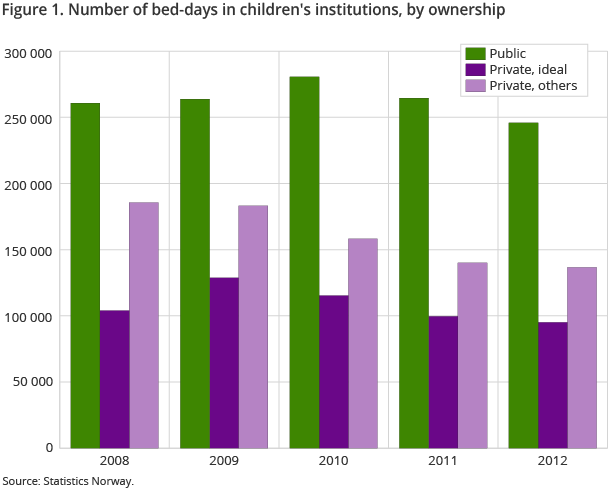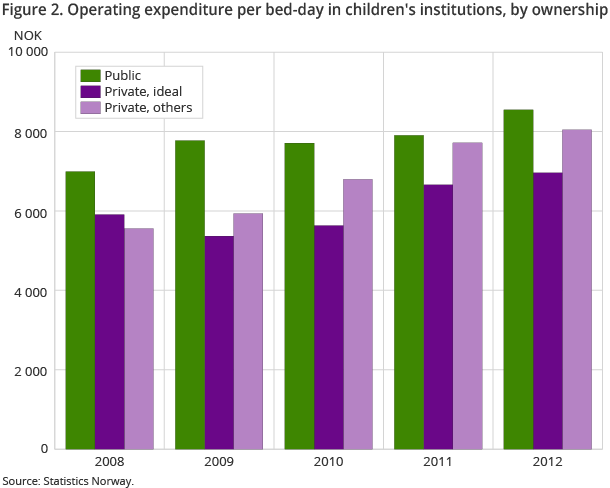Content
Published:
This is an archived release.
Reduced use of institutions
The number of bed-days in children’s institutions fell by nearly 26 600 to 477 500 from 2011 to 2012. This is more than 5 per cent down. Since 2009, almost 100 000 fewer bed-days have been registered in children’s institutions.
| Absolute figures | Per cent | ||
|---|---|---|---|
| 2012 | 2011 - 2012 | 2008 - 2012 | |
| 1Maternity homes are from the year 2010 included in the number of beds. | |||
| Number of beds1 | 1 759 | -8.6 | -4.9 |
| Number of children i childrens institutions | 1 279 | -3.3 | -15.9 |
| Treatment days (stays) during the year | 477 516 | -5.3 | -13.2 |
| Operating expenditures (NOK million) | 3 861.5 | 0.8 | 12.2 |
| Operating expenditures per treatment days | 8 087 | 6.4 | 29.4 |
| Publicly owned institutions | 8 547 | 8.2 | 15.0 |
| Owned by ideal private institutions | 6 961 | 4.6 | 17.9 |
| Owned by other private institutions | 8 042 | 4.3 | 44.7 |


The decline is spread throughout all kinds of institutions; 7 per cent down in state-owned institutions, 5 per cent in ideal institutions and 2 per cent in other private institutions. Most of the decline is due to fewer bed-days for unaccompanied juvenile asylum seekers in 2012.
Fewer unaccompanied juvenile asylum seekers
Bed-days for unaccompanied juvenile asylum seekers made up less than 6 per cent of the total bed-days in 2012, compared to 13 per cent in 2010. While unaccompanied juvenile asylum seekers previously also stayed in private institutions, they only stayed in state-owned care centres for unaccompanied juvenile asylum seekers in 2012.
Care stays most common
Care stays (which also include unaccompanied juvenile asylum seekers) were the most common (36 per cent) type of stay. Voluntary stays accounted for 33 per cent and behavioural stays 20 per cent. Acute stays accounted for 11 per cent of total stays, which is a decline from 14 per cent in 2011.
A total of 1 279 children were institutionalised in 2012, compared with 1 323 in 2011. Fifteen per cent of all resident children were aged 12 years or younger, and more boys than girls were institutionalised (56 per cent boys).
Stays in state institutions are more expensive
The institutions’ operating expenditure amounted to NOK 3.9 billion in 2012; about the same as in 2011. Operating expenditure per bed-day was NOK 8 100. Stays in state institutions are about NOK 400 more expensive than this on average.
Stable number of man-years in children’s institutions
Excluding the state-owned institutions in region West, the number of contracted man-years adjusted for sick-leave and maternity leave in children’s institutions increased by 0.3 per cent between 2011 and 2012. Region West is excluded from figure comparisons for 2011 and 2012 due to an error in the statistics for 2012. The region has reported errors to the data source for the statistics for 2012.
Contact
-
Tone Dyrhaug
E-mail: tone.dyrhaug@ssb.no
tel.: (+47) 40 90 24 20
-
Unni Beate Grebstad
E-mail: unni.grebstad@ssb.no
tel.: (+47) 94 50 68 66
